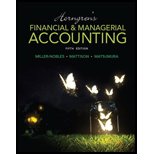
Concept explainers
1)
Profitability ratios: In general, financial ratios are used to evaluate capabilities, profitability, and overall performance of a company. The following are the ratios that evaluate the profitability of a company:
- Profit margin ratio: Profit margin ratio is used to determine the percentage of net income that is being generated per dollar of revenue or sales.
Formula:
Rate of return on total assets: Return on assets determines the particular company’s overall earning power.
Formula:
- Asset turnover ratio: Asset turnover ratio is used to determine the asset’s efficiency towards sales.
Formula:
- Rate of return on common stockholders’ equity: Rate of return on stockholders’ equity is used to determine the relationship between the net income and the average common equity that are invested in the company.
Formula:
To compute: Profitability ratios
Given info: Income statement and Balance sheet
2)
To Compute: the rate of return on total assets for Company S for 2016.
3)
To Compute: the asset turnover for the Company S for the year 2016.
4)
To Compute: the rate of return on common stockholders’ equity for the Company S for the year 2016.
5)
To comment: Whether the company is strong or weak.
Want to see the full answer?
Check out a sample textbook solution
Chapter 15 Solutions
Horngren's Financial & Managerial Accounting (5th Edition)
- The equity of Alliance Company is $198,300 and the total liabilities are $16,700. The total assets are _.arrow_forwardYou just borrowed $291,497. You plan to repay this loan by making regular quarterly payments of X for 19 quarters and a special payment of $71,400 in 7 quarters. The interest rate on the loan is 2.88 percent per quarter and your first regular payment will be made in 3 months. What is X? Input instructions: Round your answer to the nearest dollar. $arrow_forwardMaverick industries has a cash cycle of 35 days?arrow_forward
- What were the total sales revenue of this financial accounting question?arrow_forwardHelparrow_forwardSelected information taken from the financial statements of Verbeke Co. for the year ended December 31, 2019, follows: Gross profit General and administrative expenses $ 4,13,000 83,000 Net cash used by investing activities 1,05,000 Dividends paid 55,000 Interest expense 60,000 Net sales 7,40,000 Advertising expense 75,000 Accounts payable 1,03,000 Income tax expense 84,000 Other selling expenses 43,000 a. Calculate income from operations (operating income) for the year ended December 31, 2019. b. Calculate net income for the year ended December 31, 2019.arrow_forward
- In response to complaints about high prices, a grocery chain runs the following advertising campaign: "If you pay your child $3 to go buy $100 worth of groceries, then your child makes twice as much on the trip as we do." You've collected the following information from the grocery chain's financial statements: (millions) Sales $700 Net income $10.5 Total assets $380 Total debt $250 1. What is the profit margin for children as a percentage of what they spend and the profit margin for the store? 2. What is the store's ROE?arrow_forwardWhat is the contribution margin ratio?arrow_forwardWhat is the average payment period?arrow_forward
 Financial AccountingAccountingISBN:9781305088436Author:Carl Warren, Jim Reeve, Jonathan DuchacPublisher:Cengage Learning
Financial AccountingAccountingISBN:9781305088436Author:Carl Warren, Jim Reeve, Jonathan DuchacPublisher:Cengage Learning EBK CONTEMPORARY FINANCIAL MANAGEMENTFinanceISBN:9781337514835Author:MOYERPublisher:CENGAGE LEARNING - CONSIGNMENT
EBK CONTEMPORARY FINANCIAL MANAGEMENTFinanceISBN:9781337514835Author:MOYERPublisher:CENGAGE LEARNING - CONSIGNMENT


